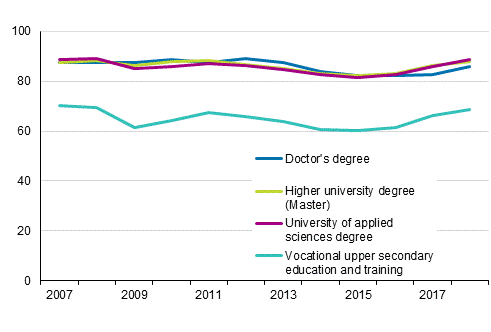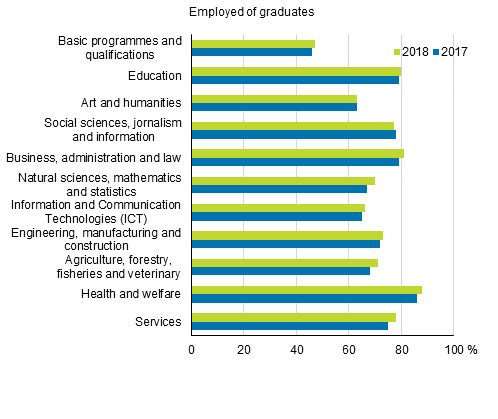Published: 23 January 2020
Employment of recent graduates continued to increase
According to Statistics Finland's education statistics, employment of recent graduates improved further. University graduates were most successful in gaining employment, close on 90 per cent of them were working at the end of 2018. Altogether 69 per cent of attainers of basic vocational education qualifications, 84 per cent of attainers of vocational qualifications and 95 per cent of attainers of specialist vocational qualifications were employed.
Employment of graduates one year after graduation 2007–2018, %

Employment among recent graduates is measured one year after their graduation. One year after graduation, 72 per cent of the graduates were employed, of whom 57 per cent were working full-time and 14 per cent were working besides studies. The share of those working full-time had increased by two percentage points from the previous year. The proportion of the unemployed was eight per cent.
Altogether 10 per cent of recently graduated women and 17 per cent of men who had attained initial vocational qualifications were unemployed
The employment of both recently graduated women and men improved by two percentage points compared to the previous year. In all, 76 per cent of all recently graduated women and 67 per cent of men were working.
Of those with initial vocational qualifications, 69 per cent were employed, 75 per cent of women and 62 per cent of men. In all, 14 per cent were unemployed, 10 per cent of women and 17 per cent of men. Altogether 16 per cent continued studying after completing initial qualifications, slightly over one-half did so besides work. In all, 13 per cent of men belonged to the group “other”, which includes, for example, non-military service and military service. Eighty-four per cent of attainers of vocational qualifications and 95 per cent of attainers of specialist vocational qualifications were working.
The employment of those with a university degree had also improved. Eighty-nine per cent of those with university of applied sciences degrees and 88 per cent of those with higher university degrees were employed one year after graduation. Women and men with university degrees found employment equally easily. Five per cent of both those with university of applied sciences degrees and those with higher university degrees were unemployed. Ninety-five per cent, as many women as men, of those with a higher university of applied sciences degree were working one year after graduation and three per cent were unemployed. Of recently graduated doctors, 86 per cent were working, 88 per cent of women and 84 per cent of men. Four per cent of them were unemployed.
There were differences in the transition to working life by field of education. Employment improved most in the field of natural sciences, by three percentage points. Altogether 70 per cent of those who graduated from the field of natural sciences were employed. The transition was easiest for graduates with qualifications from the female-dominated field of health and welfare, in which 88 per cent of graduates were employed. Employment was second best in the field of business, administration and law, 81 per cent of graduates. Unemployment was highest, 14 per cent, among those with qualifications in the field of information and communication technology (ICT).
Employment of graduates one year after graduation by field of education 2017–2018, %

The majority of those having passed the matriculation examination continued studies one year later, although only 30 per cent immediately continued studies after the matriculation examination, see Entrance to education . One year after the matriculation examination, 54 per cent of passers of the matriculation examination continued studies leading to a qualification or degree, 58 per cent of women and 49 per cent of men. Nineteen per cent worked besides further studies. Twenty-nine per cent of new passers of the matriculation examination in the previous year were working full-time, 32 per cent of women and 23 per cent of men. Ten years earlier, the share of passers who continued studies one year after graduation was 11 percentage points higher, i.e. 65 per cent.
In most university education, the right to study is for a higher university degree. For that reason, the majority of recent graduates with lower university degrees continued studies (88 per cent), as many women as men. Over one-half were also working besides studies (55 per cent).
More detailed data on the employment of recent graduates by region of residence, age, level and field of education can be found in the database tables .
Source: Education 2020. Statistics Finland
Inquiries: Anna Loukkola 029 551 3678, koulutustilastot@stat.fi
Director in charge: Jari Tarkoma
Publication in pdf-format (224.2 kB)
- Tables
-
Tables in databases
Pick the data you need into tables, view the data as graphs, or download the data for your use.
Appendix tables
Updated 23.1.2020
Official Statistics of Finland (OSF):
Transition from school to further education and work [e-publication].
ISSN=1798-9469. 2018. Helsinki: Statistics Finland [referred: 1.1.2026].
Access method: http://stat.fi/til/sijk/2018/sijk_2018_2020-01-23_tie_001_en.html

